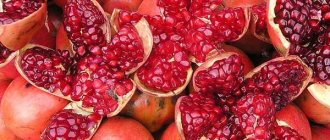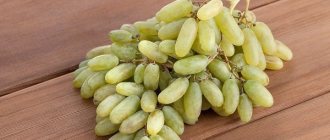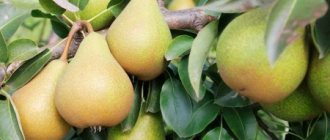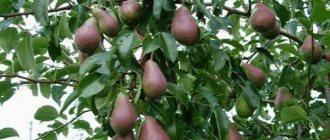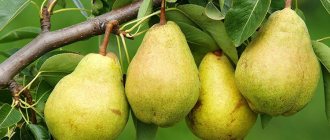Pears are sweet, juicy and incredibly aromatic fruits that usually do not cause allergies. It is not surprising that such fruits are introduced into the diet of both adults, children and pregnant women. It is believed that they can be eaten even during a diet. But is this really so? What is the calorie content of pears fresh, dried, baked and dried? Let's find out!
Yellow pear calories
Yellow pears are also very popular. The Abbot variety is a real favorite among them. They contain approximately 48 kcal per 100 grams.
Photo source: shutterstock.com
The nutritional value of the product is represented by the following indicators:
- proteins - 0.4 g;
- fats - 0.6 g;
- carbohydrates - 10.3 g.
The weight of one average fruit is 150 grams, so the calorie content of 1 piece is 70.5 kcal. Accordingly, the nutritional value of the product (BJU) is 0.5/0.6/15.5 g.
Chemical composition
The fruit contains many valuable vitamins and minerals, which make the pear a useful and necessary addition to the daily diet. The advantage of the fruit is its low calorie content, which allows it to be included in the diet of people who are on a diet.
A detailed description of the composition is given in the table:
| Components | Approximate amount for every 100 grams |
| Vitamins |
|
| Macronutrients |
|
| Microelements |
|
| Cellulose | About 3 g |
| Organic acids | From 0.5 to 1 g |
| Essential amino acids |
|
| Nonessential amino acids |
|
| Starch | No more than 1 g |
| Sahara | Up to 10 g |
| Ash | Up to 0.8 g |
| Water | About 80-85 g |
The ratio of proteins, fats and carbohydrates (BJC) in the product is uneven, which is explained by the predominance of the latter in its composition. For every 100 g there is the following ratio: 0.5/0.4/10-11 g.
The average fruit weighs from 150 to 200 g. The weight largely depends on the variety of pear. There are dwarf varieties whose fruits do not exceed 100 grams.
The calorie content of a pear also depends on the type and method of its preparation:
| Type/method of processing | Number of calories, kcal |
| 100 g edible part | From 45 to 50 |
| Dried, dried | From 250 to 270 |
| Baked (no sugar) | About 55 |
| Canned | From 70 to 80 |
| With wine syrup | Not less than 150 |
The fresh fruit with peel has the lowest calorie content. In 1 piece medium size only 65 to 100 kcal.
Garden pear: calorie content
The common domestic variety is very common. We most often call it garden. But what are the KBJUs of this fresh fruit? When taking into account the value of nutrition during weight loss or on PP, you need to take into account the following indicators per 100 grams:
- 42 kcal;
- proteins - 0.4 g;
- fats - 0.3 g;
- carbohydrates - 10.9 g.
Typically, 1 average Ural pear weighs just 100 grams, so the indicators remain the same when only one fruit is included in the diet.
Wild fruits are slightly higher in calories. For 1 piece accounts for 47 kcal.
Beneficial and harmful properties of pear
- The benefits of the Conference variety are due to the high concentration of elements valuable for the human body:
- organic acids help the gastrointestinal tract;
- iron supports hematopoiesis, transports oxygen in the body, prevents anemia;
- copper stimulates the absorption of proteins and carbohydrates and is indispensable for cardiac activity;
- chromium helps regulate blood glucose levels;
- potassium ensures prevention of salt deposits;
- fructose has a positive effect on pancreatic function;
- essential oils are needed to fight infections and inflammation;
- fiber normalizes cholesterol, promotes the removal of bile, and gives a feeling of satiety;
- tannins are a natural remedy for diarrhea;
- antioxidants are necessary to normalize blood pressure;
- vitamins strengthen and tone the entire body, improve the functioning of the immune system.
In addition, pear has a diuretic, analgesic and expectorant effect; used externally to restore skin tone and freshness.
Pears are not harmful to a healthy person, but spoiled fruits often cause stomach upset. It is preferable for older people to eat durum varieties not raw, but boiled or baked. Also, these fruits complicate the absorption of protein, so you need to take a break of at least 30 minutes between eating meat and pears. The question of whether a pear strengthens or weakens a chair cannot be given a definite answer.
Did you know? Before the appearance of tobacco in Europe, brought from America, our distant ancestors smoked the leaves of several other plants, including the pear tree.
It can produce both effects, depending on the form in which it is consumed. The juice of fresh fruits irritates the intestinal walls, causing increased secretion and a laxative effect. While eating dried fruits, due to the high concentration of tannins and tannins, can strengthen the stool.
For children
Pear is a hypoallergenic fruit, so it is usually given to babies before they are one year old, especially since it is easier to digest than, for example, an apple. However, like any new product, it must be introduced gradually, since individual intolerance is sometimes observed.
The pear contains an excellent vitamin and mineral cocktail that is beneficial for the health of a growing organism. Decoctions of dried fruits help with digestive problems and colds. The seeds are used as an anthelmintic and help against diarrhea. The fruit increases the body's defenses and reduces the likelihood of contracting a viral infection.
Folic acid is especially necessary for pregnant women, as it helps form the baby’s nervous system and prevent defects in its development. And vitamin E is involved in the production of hormones and strengthening hair and nails.
Ascorbic acid protects the body from infections, potassium and calcium support the activity of the heart muscle and preserve tooth enamel, and fiber helps get rid of a common problem in pregnant women - constipation.
What else is useful about a pear is that it can be included in the diet of a young mother already in the first month of the baby, while carefully monitoring his reaction. Thus, the baby, together with mother's milk, will absorb the valuable substances that the fruit is rich in.
When losing weight
During weight loss, pears help restore the supply of valuable elements, practically without increasing the calorie content of the diet, since they have a rather low nutritional value. The high fiber content will gently cleanse the intestines and remove accumulated waste and toxins from the body.
Important! The KBJU indicator of pears indicates their fairly low calorie content, which allows the product to be actively used in dietary nutrition.
Calorie content of Chinese pear
Chinese pears are very tasty; the most popular varieties are crystal and nashi. But what is the energy value of this variety?
Photo source: shutterstock.com
There are 42-45 kcal per 100 grams of Chinese pears. This is a low-calorie species, and therefore can be safely included in the diet. The ratio of BZHU for this variety is as follows:
- proteins - 0.42 g;
- fats - 0.11 g;
- carbohydrates - 11.47 g.
Such fruits are large and weighty, and 1 Chinese pear weighs about 200 grams. Accordingly, the calorie content of one piece varies from 84 to 90 kcal. Therefore, it already contains 0.84 g of protein, 0.22 g of fat, and about 23 g of carbohydrates.
Beneficial features
The benefits of pears in any form for the body are undeniable, since they contain a large amount of valuable substances that are daily necessary for the normal functioning of organs and systems.
The most significant medicinal properties of the fruit:
- normalizes digestion and prevents decay processes in the small intestine;
- stimulates metabolic processes and promotes weight loss;
- helps the rapid evacuation of toxins and waste;
- cleanses the blood and stimulates hematopoietic processes, increases hemoglobin levels;
- prevents loose stools and normalizes intestinal microflora;
- strengthens the heart muscle;
- normalizes cholesterol levels in the blood and prevents the deposition of cholesterol plaques on the walls of blood vessels;
- reduces capillary permeability and strengthens the vascular wall;
- stabilizes the psycho-emotional state;
- prevents thyroid diseases;
- helps in removing parasites;
- has anti-inflammatory, antibacterial and mild diuretic properties;
- promotes healing of wounds and cracks;
- strengthens teeth and bones;
- slows down the growth and development of atypical cancer cells;
- eliminates heartburn and stomach pain.
For men, the fruit is useful because it prevents the development of inflammatory pathologies of the prostate gland, increases endurance and physical strength, relieves fatigue after prolonged and intense exercise, improves sexual function and prevents its early decline.
For women, the fruits are valuable because they help normalize hormonal balance and the menstrual cycle, alleviate the symptoms of menopause, prevent stress and depression, strengthen hair and nails, improve the condition of the skin and prevent early aging.
During pregnancy, eating pears helps the normal growth and development of the fetus, prevents defects and anomalies, supports the mother's body and prevents exhaustion.
For children, pear in moderation is extremely beneficial because:
- strengthens the immune system;
- replenishes the deficiency of minerals and vitamins;
- improves memory, concentration, sleep;
- promotes normal development of the musculoskeletal system.
Calorie content of pear Conference
There are many different varieties of pear, and one of the most popular among them is the Conference. But if you decide to enjoy it, it’s worth knowing how many calories are in 100 grams of such fresh fruits. This volume accounts for 48 kcal, as well as:
- proteins - 0.7 g;
- fats - 0.9 g;
- carbohydrates - 11.7 g.
Since 1 pear weighs approximately 100 grams, these figures can be taken into account when adding one fruit to your diet.
ABC RECOMMENDS
How many calories are in an apple: table by varieties with BJU
Features of use
The most preferable option is to eat pears with their peels raw.
Those who suffer from any pathologies of the gastrointestinal tract are recommended to bake fruits in the oven or microwave without sugar. This will allow you to benefit from the product without harming your digestion.
Dried fruits are recommended to be consumed in limited quantities, since their calorie content is high. 50 g per day is enough to compensate for the deficiency of useful components. Canned fruits using a minimal amount of sugar are best for young children who do not want to eat fresh fruits. Pear in wine syrup is suitable for dessert. Consumption is permitted only for adults and in limited quantities.
The daily intake of fresh fruit for an adult is 2 medium-sized pieces. For a child from 7 years old, 1 pear is enough; from 3 to 7 years old, 50 g of pulp without peel is the norm. Up to 3 years old, you should give your baby no more than a piece. Women during pregnancy should not exceed a dose of 150 g of product.
Williams pear calories
The Williams variety is also one of the most popular. What are its main indicators?
Photo source: shutterstock.com
Calorie content is 60 kcal, and the nutritional value per 100 grams of product is as follows:
- proteins - 0.53 g;
- fats - 0.21 g;
- carbohydrates - 12.51 g.
Since 1 medium-sized fruit weighs just 100 grams, the indicators remain unchanged.
Calorie content of dried pear
What is the energy value of dried pears, with which you can diversify your diet? During processing, fruits are deprived of a large amount of moisture, so their sugar levels increase. Therefore, the calorie content of such a dessert turns out to be not at all harmless. Per 100 g - 246 kcal. They contain no fat at all, but carbohydrates and proteins - 62 g and 2 g.
Photo source: shutterstock.com
Since 1 dried pear weighs about 25 grams, it turns out that its energy value is 61.5 units. There is no fat either, but carbohydrates and proteins - 15.5 and 0.5 g, respectively.
Composition and nutritional value of pear
Nutritional value is determined by the unique chemical composition of the product. It is not surprising that the pear is called the queen of fruits for its high content of vitamins. What is the chemical composition of this fresh fruit, which is always so pleasant to snack on?
Photo source: shutterstock.com
It is represented by the following components:
- choline;
- calcium;
- ascorbic acid;
- potassium;
- thiamine;
- retinol;
- zinc;
- folic acid;
- B vitamins;
- fluorine;
- iron;
- copper;
- alimentary fiber;
- selenium;
- riboflavin, etc.
Here are just the most basic components that make such food valuable and beneficial for vision, brain, intestines, heart and other organs. Pear has a beneficial effect on memory, concentration, and performance, which is why it is so important to include it in the diet of adults, children and pregnant women.
ABC RECOMMENDS
What is the calorie content of watermelon per 100 grams: composition, benefits and harms, BJU
Pears for children
An appetizing, aromatic, rich pear is necessary for both adults and children.
Its rich composition, which contains vitamins and minerals, promotes the growth and development of the child’s body, enhances immune defense, and has a good effect on the functioning of organs. Pear does not include any allergens. This fact makes it possible to include it in the diet, even for young children. For children under one year old - these are purees and juices. If a child has a predisposition to an allergy to the fetus, pediatricians recommend not giving a pear.
Read: Foods that cause fermentation in the human body
Pears are recommended to be introduced into food for babies from 6 months, juice - a little earlier, from 4-5 months. When introducing it into a child’s diet, it is important to observe the body’s response: there may be difficulties with the intestinal tract. In case of negative interactions, the fetus should be discarded. A pear is more easily absorbed by a child's body than an apple.
Traditional medicine uses pears as a remedy for colds or persistent coughs. They are also considered one of the least sensitive fruits, so they are recommended for allergy sufferers and children aged 6 months and older.
A pregnant woman's diet should also be rich in pears due to their folic acid content, which is so necessary during this period.
The benefits and harms of pears
According to doctors and leading nutritionists, pear has many positive properties:
- strengthening the heart muscle;
- blood purification;
- stabilization of psycho-emotional state;
- stimulation of metabolic processes;
- normalization of the gastrointestinal tract.
Pear strengthens the walls of blood vessels, promotes weight loss, normalizes brain function, improves attention, memory and performance in general.
Pears also effectively remove waste and toxins from body tissues. They normalize hemoglobin levels in the blood, strengthen bones and teeth, help eliminate parasites, and prevent the development of thyroid pathologies. The fruits relieve stomach pain and heartburn. Oncological formations are not allowed to develop. They have antibacterial, healing, anti-inflammatory and mild diuretic effects.
Photo source: shutterstock.com
But pears are distinguished not only by their beneficial properties. In some cases, they can harm the human body. Therefore, it is so important to take into account contraindications to the consumption of sweets, which the ancient Romans called “flame”. These include:
- exacerbation of colitis;
- nervous disorders;
- acute gastritis;
- various gastrointestinal pathologies associated with high acidity;
- old age, when it is difficult to digest such foods.
It is recommended that people with type 2 diabetes mellitus avoid such fruits (especially in dried form), since the glycemic index of pears is 34 units.
Photo source: shutterstock.com
Please note that if you lean too much on pears, you may experience constipation and bloating. You should not consume them at night or on an empty stomach, since the fruit is rich in fiber. It is better to enjoy it 1-1.5 hours after the main meal.
Pears of any variety do not interact well with heavy foods, slowing down the work of the stomach. Therefore, you should not mix these fruits with meat.
How to eat a pear correctly Conference?
You should eat only ripe and soft fruits. The pear retains the desired properties even after heat treatment.
It is not recommended to use fruits in the morning before meals and immediately after meals, especially if it includes meat dishes.
Doctors consider pears an excellent alternative to confectionery.
It is recommended to use pears with their peel, which is an excellent source of valuable fiber. They should not be consumed if you have intestinal disorders or on an empty stomach.
Pears are also excellent in a variety of fruit salads and desserts.
Thus, this variety of pear is a very healthy fruit for everyone. It can be used in any form and retains its good properties. There are some rules for using the fruit that should be followed to avoid unpleasant sensations.
You can find out which apple or pear is healthier from the following video:
Read along with this article:
- What are the benefits of bananas for the health, youth and beauty of women?
- Goji berries - calories, beneficial properties
- Is dried fruit compote really healthy?
- What fruits can you eat if you have a stomach ulcer, and which ones will you have to...
- Foods containing large amounts of protein: benefits for the body
- Benefits for the body and calorie content of baked apples
- Loquat is a fruit known as a traditional medicine.
- What is cow colostrum, the benefits and harms of the product
- Coconut milk calorie content, composition, properties
Calorie table for pears
To make it easier to navigate the calorie content of all varieties of pears and dishes based on them, you should use the table:
| The product's name | Calorie content (kcal) |
| Duchess | 57 |
| Earth variety | 74 |
| Red variety | 57 |
| Canned in its own juice | 50 |
| Dried | 246 |
| Dried | 270 |
| Pear juice | 46 |
| Pear puree | 52 |
| Bere Bosc | 67 |
| Conference | 48 |
| Chinese | 42 |
| Forest beauty | 47 |
| Trout | 42 |
| Anjou green | 66 |
| Packham | 42 |
You will find the recipe for a healthy dietary dish with pear in the video:



